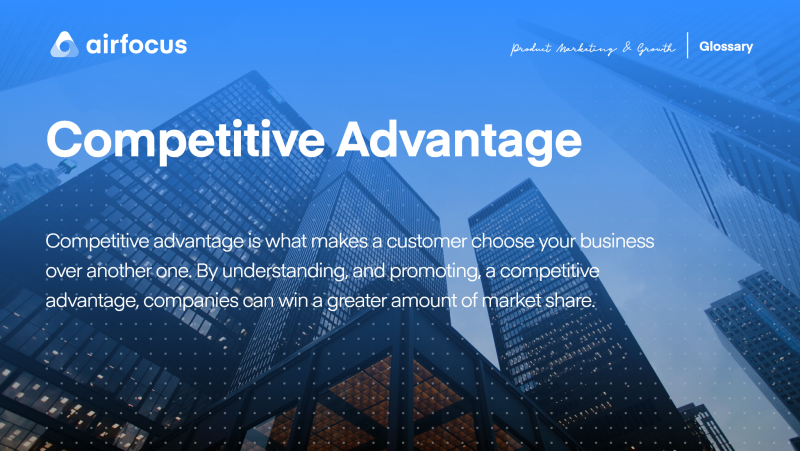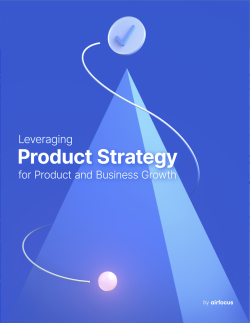Competitive Advantage
What is competitive advantage
Definition of a competitive advantage
Competitive advantage is what makes a customer choose your business over another one. By understanding, and promoting such advantage, companies can win a greater amount of market share.
A competitive advantage may stem from the user experience — that is, a better, more affordable or more enjoyable product — or it may be another tangible or intangible asset, such as the intellectual property or the customer service team.
Examples of competitive advantage
Competitive advantage separates a surviving business from a thriving one, but the source can change from sector to sector and company to company.
Some common examples of competitive advantage include:
The team
Unique access to technology or production methods
A product that no-one else can offer (protected by IP law or patents, etc.)
Ability to produce and sell at a lower cost (known as cost leadership)
Brand and reputation
Whilst you may launch into the market with a totally novel idea, it may not be long until rivals catch up. That’s when you may need to revisit what your competitive advantage can be.
In the case of sectors with many copycat brands, such as soft drinks, brand and reputation may be the most powerful advantage to harness.
How to identify your business’s competitive advantage
What can you offer to your audience, that none of your rivals can claim to?
To identify your advantage, you must map out:
How you deliver value or benefits to customers
Who your target market is
Who else is operating in the same, or similar, space to you
Your competitive advantage lies in unlocking the most engaging benefit, for your target audience, and delivering it in a way that no other business can.
It’s possible you’ll have several possible competitive advantages, the one you choose to promote in your marketing and brand communication should be the one with the greatest differentiation and potential to engage. This will help you to get a bigger market share.
Why is competitive advantage important?
There is so much competition to face, no matter which area you’re targeting, so having the upper hand is crucial for success. Here’s why competitive advantage is so important in this volatile business landscape.
Differentiation
Your product or service must stand out in the market by offering unique features, superior quality, or innovative solutions. Customers are looking for something distinct that makes you the obvious choice.
Profitability
By offering something competitors cannot easily replicate, you can charge a little extra to boost profit margins. This allows you to capture a larger market share and achieve greater profits.
Customer attraction
Competitive advantage helps you attract and retain customers, creating a loyal customer base that can provide repeat business and positive word-of-mouth referrals.
Brand loyalty
Competitive advantage fosters brand loyalty among customers. When customers recognize your business's unique value, they are more likely to develop an emotional connection and loyalty to your brand.
Talent and investment
Employees are drawn to innovative, successful companies that offer growth opportunities. As a bonus, investors are more likely to invest in companies with a clear competitive advantage, which indicates a higher potential for long-term success.
Types of competitive advantage
Competitive advantage isn't just about having a product another company doesn’t. There are different types of competitive advantages that a business can use to get the upper hand, including:
Differentiation
Differentiation is the most common form of competitive advantage we hear about. It’s about creating valuable points of difference between your business and your competitors. This could be product quality, brand image, unique features, marketing, etc.
SaaS companies often focus on developing unique features that address existing customer needs. This also brings a secondary competitive advantage of customer-centricity — a huge selling point for modern customers looking for validation and care from their favorite brands.
Cost leadership
Some companies gain a competitive advantage by streamlining their finances with surgical precision. They will look to reduce production costs as much as possible, cutting down on waste, reducing the complexity of their supply chains, and more. They then pass the savings on to the customers. This helps attract new customers looking to cut their own costs in a rocky economy, leading to brand loyalty and word-of-mouth advertising.
Focus
Focus advantage occurs when a business is targeting its products, services, or marketing efforts to cater to a minority section of its typical target audience. A focus strategy enables companies to pinpoint and meet the needs of their most reliable customers. It takes more effort than targeting a broad audience, but it can often yield highly positive results for customer satisfaction and profitability.
What is sustainable competitive advantage?
Sustainable competitive advantage helps businesses rise above the competition over a long period of time. It helps influence consumer decision making and often results in higher profits.
Sustainable competitive advantage refers to assets, characteristics, or capabilities that are unique to a business. They are difficult to replicate and allow a business to meet customer demands better than its competitors. Without a sustainable competitive advantage, you risk your business just being another drop in the ocean.
There are three main types of sustainable competitive advantage: differentiation, cost leadership, and focus advantage.
What is differentiation as sustainable competitive advantage?
Differentiation refers to how a business tailors its strategies to help clearly set them apart from its competitors. This could come in the form of high-quality products, strategic assets, intellectual property, brand identity, and so on.
What is cost leadership as sustainable competitive advantage?
Companies that can bring down their costs and pass those savings down to the customer have what we call pricing power. This competitive advantage allows businesses to price lower than their competitors so consumers choose their products on the basis of financial value.
What is focus advantage as sustainable competitive advantage?
Focus advantage is when businesses target a specific section of their target audience to build greater customer satisfaction and loyalty.
Sustainable competitive advantage is one of the most valuable things a business can have.
It’s a major driver of long-term business and is often the most sought after part of any business acquisition.
Competitive advantage framework
The most common competitive advantage framework is the VRIO framework.
VRIO is an internal analysis tool that can be used to categorize resources based on whether they hold certain traits that are outlined within the framework.
This categorization allows organizations to identify which company resources are actually competitive advantages.
There are four stages to the VRIO competitive advantage framework, each resource goes through the four stages to help identify if that resource is a competitive advantage.
Valuable - Does this resource offer a tangible benefit?
Rare - Is this resource found within other organizations, or is it unique?
Inimitable - Is this resource difficult to reproduce or copyrighted?
Organized - Is this resource organized in a way that captures value?
A resource that is valuable, rare, hard to imitate, and organized to capture value is a long-term competitive advantage. It’s worth keeping in mind that a single resource that offers a competitive advantage is not a guarantee of value or success, and it may only be a temporary situation. The best companies know this and always have an eye on the future.
What is the best competitive advantage book?
For those looking to learn everything there is to know about sustainable competitive advantage, here are some great books to add to your list.
Picking just one is hard!
The Hawke Method by Erik Huberman - Packed full of real-world examples of successful business strategies.
Rare Breed: A Guide to Success for the Defiant, Dangerous, and Different by Sunny Bonnell and Ashleigh Hansberger - Great for those who love to think outside the box.
The Lucky Formula by Mark Lachance - A brilliant tale of how Lachance turned his luck around.
The Trap of Success by Gene Hammett - Hammett gives you the knowledge you need to break out of your comfort zone.

General FAQ

Glossary categories
Create effective product strategy

Experience the new way of doing product management








